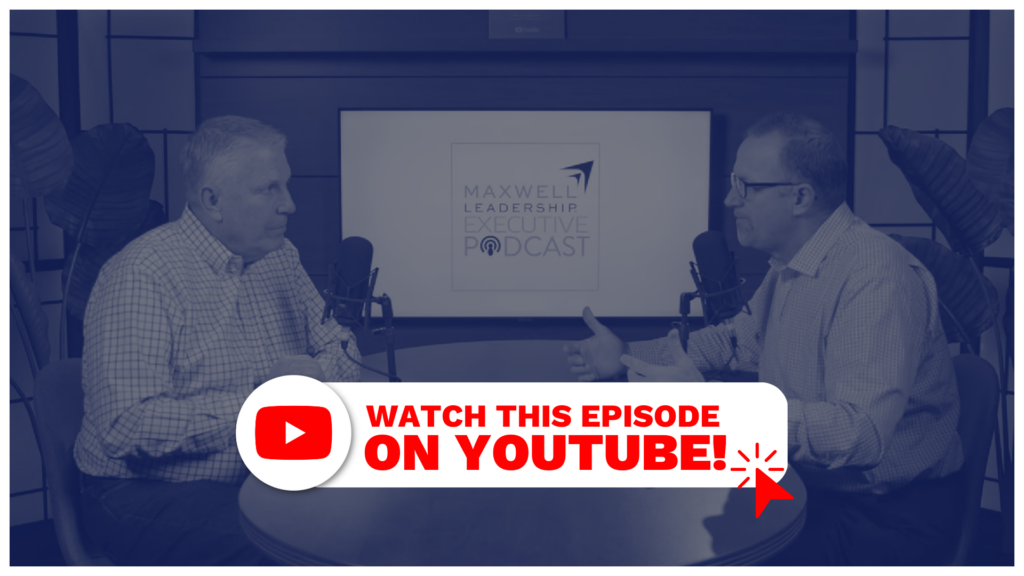Executive Podcast #282: What If My Team Is Not Following My Change Lead?

In this episode we explore the vital significance of influence and engagement in driving transformation. From understanding various reactions to change, from resistance to acceptance and beyond, to unraveling the pivotal role of effective communication in guiding individuals along this journey.
References:
Become a Maxwell Leadership Certified Team Member!
Register for Day to Grow on March 9th, 2024!
Download our Learning Guide for this podcast!
Perry Holley:
Welcome to the Maxwell Leadership executive podcast, where our goal is to help you increase your reputation as a leader, increase your ability to influence others, and increase your ability to fully engage your team to deliver remarkable results. Hi, I’m Perry Holly, a Maxwell leadership facilitator and coach.
Chris Goede:
And I’m Chris Goede, executive vice president with Maxwell leadership. Welcome and thank you for joining. Today we’re going to talk about what if my team is not following my change lead. This has never happened to me. Has it happened to you, Perry?
Perry Holley:
No, this is totally a fiction thing.
Chris Goede:
As we talk about coaching and training and working with clients and as we lead ourselves, there’s no doubt that this happened. So I’m looking forward to diving into that title with you today. Before we get started, I want to encourage you to go to maxwellleadership.com/podcast. There, if you’ll click on this episode, there’s a form, and if you’re interested in some coaching or training, virtual or in person, we were just talking before we started a little bit ago. Perry’s coming off the road, getting back on the road, and going to serve some clients of ours. And so we would love to serve you and your team as well. Well, the first place that my mind goes when we start talking about this is people not following your lead, regardless of whether it’s changed or not. Right.
Chris Goede:
It goes into what is your influence level with your team? And John often says, hey, the first place you probably want to look if that’s not happening is in the. And so talk a little bit about where this is coming from. I know we’re building off of a series on change, but it’s relevant to some of the things that you’re dealing and hearing in the corporate environment.
Perry Holley:
Yeah, this comes up. I think I’m doing it right. But people aren’t following the lead. I don’t know if they don’t understand, if they’re not bought in, blah, blah, blah. I said, well, I’m hearing John in my mind saying, if you think you’re leading and you look and there’s nobody following, then you’re just out for a walk. And I think it does play nicely into where you were going there without influence. And my number one go to on that as well as yours is the five levels of influence and thinking. Man, if people aren’t following, then what is my problem? Like I said in the mirror, it is me, and it is the influence level I have with people, and can I affect that? So that’s where I was thinking, if.
Chris Goede:
You’Re new to our podcast, Perry and I have built this thing off of the five levels of leadership, and it’s a model, it’s a methodology that John created 20 plus years ago. Started out as a chapter in a book called developing the leader within you. And there was quite a bit of traction around it, so he wrote a book around it, and now we have our consulting, training, coaching business that’s built around it as well. At the simplest form, it is a model of influence. And what we’re talking about here is that at level one, people follow you because you have the title of leader, manager, boss, whatever it might be, and they have to follow you. That may be what’s happening here. Right. You may be getting some resistance, and then they’re not following you because they have to.
Chris Goede:
So they’re kind of pushing back a.
Perry Holley:
Little bit, kind of a salute and stay mute.
Chris Goede:
Yeah, they don’t wake up excited about coming to work every day. But what we want you to understand is that you’ve got to progress as a leader to level two influence, which is how do I connect with them? How do I build relationships with them so that they want to follow us? And at the core of what we’re talking about today, we want to get people that will give us discretionary effort, that will want to be a part of what we’re doing, whether it’s everyday work or going through some tough change.
Perry Holley:
Yeah, I think after you do the influence check, definitely that’s my go to is, are people following me because they want to or they follow me because they have to? That’s a great indicator right there. And then, you know, the second place where I go, if you’re having trouble getting followership to your change lead, is how do people respond to change efforts? And I’ve heard this taught by a guy named Jim Keenan, and then I also heard Mark Cole, our CEO, do a bit of talk on that as well. But there’s three descriptors that come out around how people can respond to change. And I thought maybe I would just get your point of view on some of these. And one that we talked about a couple of weeks ago about resistance, but it’s a change resistor. And you might hear to someone that’s a resistor to change is I kind of just like things the way they are. It’s going to take that person out of their comfort zone. It may put them at odds with the progress that’s going on around here.
Perry Holley:
It keeps them from participating in growth at all. So this resistor, kind of like you said, they’re putting their hands up, salute. Stay mute and not participate. But I wonder how you see these resistors.
Chris Goede:
Yeah, as Perry mentioned two weeks ago, we dove into this, and so I’d encourage you, if you didn’t hear that lesson, to go back and really deep dive into resistance because we spent a lot of time on it today. We’re just hitting it from a high level. For me, it’s about communicating the why. You’re going to get resistance from people. We’ve talked about that it’s going to be different levels. And so we need to make sure that we can help them understand. And by doing that, you have to communicate the why to them and then the how that’s going to affect them and have empathy with them. Show understanding, but make sure that you’re getting to a point to where you’re moving them from being a change resistor to someone that’s beginning to understand why the change is happening.
Chris Goede:
Because if they don’t, they’re going to become irrelevant and we need to continue to move forward.
Maxwell Leadership Certified Team:
Hey, podcast listeners, many of you listening right now would probably love the autonomy that comes with owning your own business or becoming a coach that helps other businesses succeed. Well, we have a phenomenal strategy where you are 100% in control of your own business, earning income on your own terms, and have access to the people, tools and resources you need to build a thriving leadership development business. When you become a Maxwell leadership certified team member, you join a global community of entrepreneurs led by our expert team of mentors and faculty, including John C. Maxwell. You’ll also get one of the top leadership certifications in the world next to your name, giving you the boost you need to get started. Visit us online at forward slash. Join the team to find out more.
Perry Holley:
The other one, that was interesting. It was kind of deceptive, it said. Keenan called it the change acceptor. I thought, what? Isn’t that good? But it qualifies as they have a wait and see what happens mentality. So let’s wait and see how this they think that it’s going to be a train wreck. They’ll just sit back and watch, but they acknowledge the change, but they don’t initiate anything. So they’re kind of sitting back with their arms folded. They let others lead out in that and they value safety and comfort too much.
Perry Holley:
They’re not really bought into the change, but they’ll accept the fact that you have change. And I’m thinking this could have a real negative effect on change efforts because now I think, I think people are following my lead, but they’re not initiating, they’re not taking action. They’re falling back into comfortable ways. You’ve seen this happen.
Chris Goede:
Yeah. And I want to encourage all leaders, not just through change, but in every day, when you feel this and you feel like they’re just the accepters, more than not, they are probably disengaged inside your organization. Perry has given the example before about rowing the boat, and ten people in the boat and the five in the middle are just along for the ride. What am I doing on a daily basis just to get by in order to get my paycheck. So that’s in essence what they’re probably doing in this thing, too here. It’s like, what do I need to do just to get to Friday to get another paycheck? What is going to happen? And they’re holding back from fully committing, by the way, in everyday work, but also with the change. And so you need to, as a leader, be aware of that. They’re asking questions like, do I really believe in this change? To your point, is this something that is worth pursuing? Do I understand the reason for change? Can I logically, which is a challenge for me all the time when we go through changes, can I logically make sense of the change or this one, which can be very detrimental to organizations and leaders, which is, oh, I’ve heard this before.
Chris Goede:
We’ve said we’re going to do this. We said we’re going to do these kind of things. They’re not really serious, or are we serious? And they’re just sitting on the sidelines with the oars on the lap, just watching as the boat goes by.
Perry Holley:
And I totally love that you added that. I hear this from people, especially people I’m coaching. They said, our organization is going through a big change, and I just don’t agree or I don’t. Like I said, well, what’s holding you back? And they say, well, they’ve done this before. And it’s almost like in my mind there’s a start and stop pattern of we start a change effort. Something got hard or something unexpected occurred and we stopped and then we paused, and then we come back and we say, okay, now we’re going to do this and start and stop. It’s almost like crying wolf a bit that people say, well, I’ll just wait out this out because this is not going to work. It never works.
Perry Holley:
We’ll just buy our time. Bias, when you think about, I want to move. The final group that they talk about is a change creator, but I wonder if you know this. Maybe we have some bad starts and stops. Maybe we have some bad history, but can you move a change acceptor where they’re not initiating, sitting back, waiting to see, biding their time? Can you move them toward this change creator?
Chris Goede:
I think you can. And I think it all comes back to your ability to communicate the change to them. And we did a session last episode where we. The communication skills of a successful leader that’s led through change. And so in there, we talked about clarity. We talked about consistency. We talked about understanding what’s in it for me, from their perspective, how are you helping communicate that? And then how do you evangelize and paint a picture for the future of what that looks like while you’re communicating? And we closed it by saying, hey, there’s more to just communicating the change, and you need to be aware of that. And I think if you can really take time to think about that and seriously approach your communication about the change, you can move them from the middle of the boat to the front of the boat.
Perry Holley:
Yeah. Cool. Well, the third category that was mentioned was a change creator. And so we had the change resistor, the change acceptor, but now the change creator. And these are today’s problem solvers. I remember several weeks ago we talked about, can you coach your team to be change agents? Are they looking for change? So these are the problem solvers. They believe that there’s progress in change. They recognize there’s no growth, no innovation without change.
Perry Holley:
They pull the organization forward. So you’re looking for people like this on your team. You’d love to have an entire team of people like this that are really pulling us forward to the next level. But what do you think? Can you get everybody on the team to adopt to this?
Chris Goede:
I think it would be good to have most people on this, but not everyone. I heard this analogy one time. They were like, listen, we were talking about today. You and I were talking about a training course that we do called discovering your authentic leadership style. And we’ve partnered with an organization called Right Path, and we do assessments, and we take the results of the assessments, and that’s what we base the course off of. And we were in a room one time where the CEO had this high kind of risk tolerance, in essence. Right. And the problem with that was, it’s awesome that you have that type of creator, that type of risk.
Chris Goede:
Their CFO also had a high risk tolerance, which is like, you tell me where we’re going, what we’re doing, and I’ll write the check. Right? Like, you want to have some checks and balances to that, and it may be part of your culture that you are heavy on that side. And you do need to have that. By the way, I would encourage you, if you don’t have enough of them creators, you need to think about, how do I get some change creators around you or on your team to be part of your culture? Because when that happens, when you have innovation and creativity and you accept change in your culture, more than not, you’re giving people permission to make mistakes. You’re giving them the freedom to create. You’re giving them the opportunity to work a little bit harder and get outside the box and do things a little bit differently there. You’re okay with them implementing change, the productive change that has taken place in the years past. You’re awarding that, you’re celebrating that you’re creating that culture.
Chris Goede:
And so I think with all of that, then the organization moves the needle a little bit faster. So having change creators is really good. We want to move people to be that. I think there’s a little bit of balance, though, to make sure that we have some people. And I’m speaking because I’m on the logic side, right? I’m like, whoa, slow down a little bit. What about x, y, and z? But it is something that is definitely.
Perry Holley:
Beneficial for the organization, I think just knowing, like you said, the engagement rowboat, do I take assessment of who are my rowers, who are my watchers, who are my sinkers when it comes to change and communicating change? I think you need to take a assessment of who are my resisters, who are my accepters, and who are my creators and then lead appropriately. So I want to wrap it up for you.
Chris Goede:
Yeah. Well, as we begin thinking about this, as Perry said earlier on, this is an influence thing, right? We want you to think about this in the terms of change, because that’s kind of the theme that we’re talking about right now. But this is a leadership thing. And as we begin thinking about change, you want the people around you to be champions of the change with you. You want them to be in that boat. You want them to be in the first three seats rowing. As you compete against other organizations in your ecosystem, if they’re not following you, then I think you got to look internally about your influence and about your leadership with them. So there’s three things that may be happening that you need to be aware of.
Chris Goede:
Number one, you lack a strong connection with them. We talked about a level two influence. You haven’t done the work to set the foundation to lead them appropriately. And then when change happens, it’s probably showing up. It’s probably magnified. Maybe I wrote this down, thinking about, again, the rowing thing. Maybe you’re pulling in the wrong direction. Maybe the organization is going one way.
Chris Goede:
And here you are as a leader trying to create a change that’s going in the wrong direction. So you need to check that as well. And then finally, maybe you’re going a little bit too fast. I think about the movie, which I’ve mentioned to you before. You probably heard the boys in the boat, right? Yeah, I know. There’s a book out. It’s fantastic. The movie is out.
Chris Goede:
There’s a pace at which everybody needs to be moving as they’re charting the course, as they’re making changes. And so you need to make sure that we’re all moving at the same pace, which also includes the leader of the boat who is setting the pace and making sure that he’s not going too fast. So just a couple of things to think about when I was thinking about the opposite side of this, of things that could happen if you’re in a place to where your team’s not following your lead as you go through change.
Perry Holley:
Super. Thank you. Great insights. Just a reminder, if you’d like to get the learner guide for this episode, learn more about our offerings or leave us a comment or a question. You can do all of that at maxwellleadership.com/podcast. We love hearing from you. Very grateful you spend the time with us.
Perry Holley:
That’s all today from the Maxwell Leadership executive podcast.
To be a Successful Leader, You Need Feedback on Your Leadership.
We’re excited to announce our new and improved Organizational Effectiveness Survey (OES). The OES gathers feedback from employees to give leaders and management the knowledge and action plans needed to develop a more effective and productive work environment. Our new version measures 4 areas of your business: Leadership, People, Strategy, and Performance.













Be the first to comment on "Executive Podcast #282: What If My Team Is Not Following My Change Lead?"